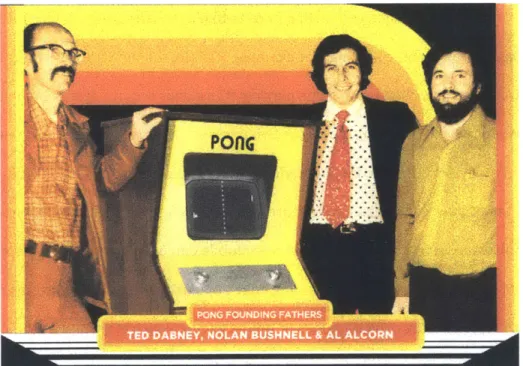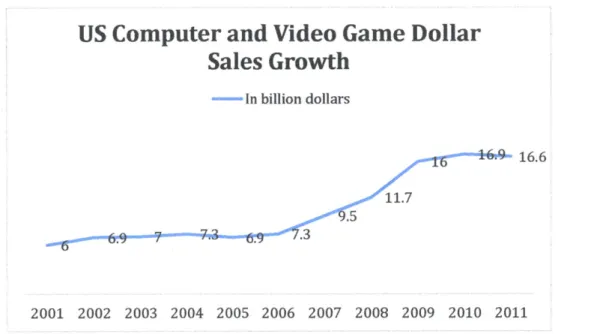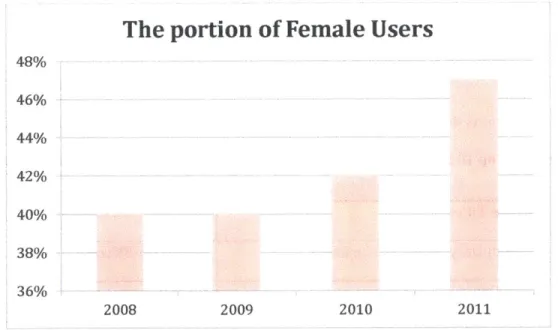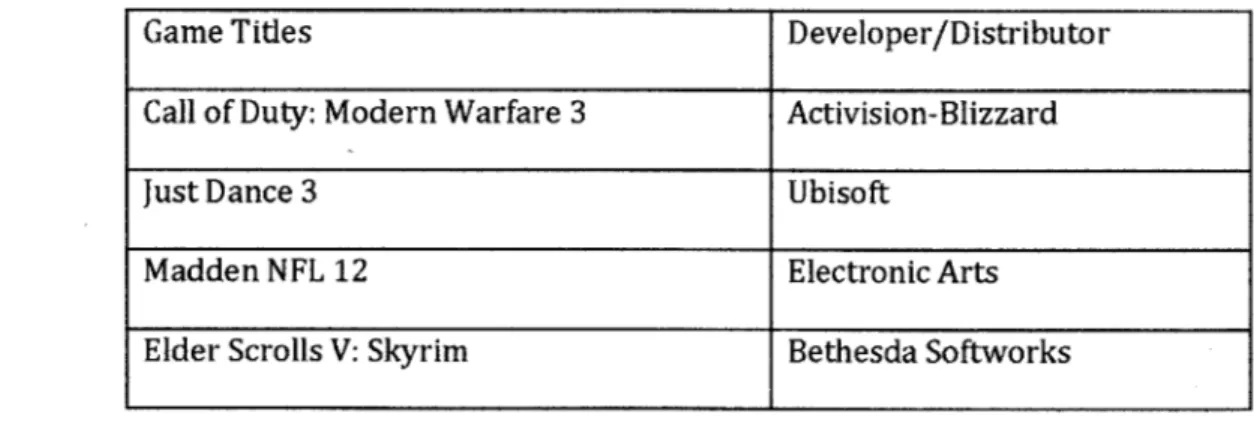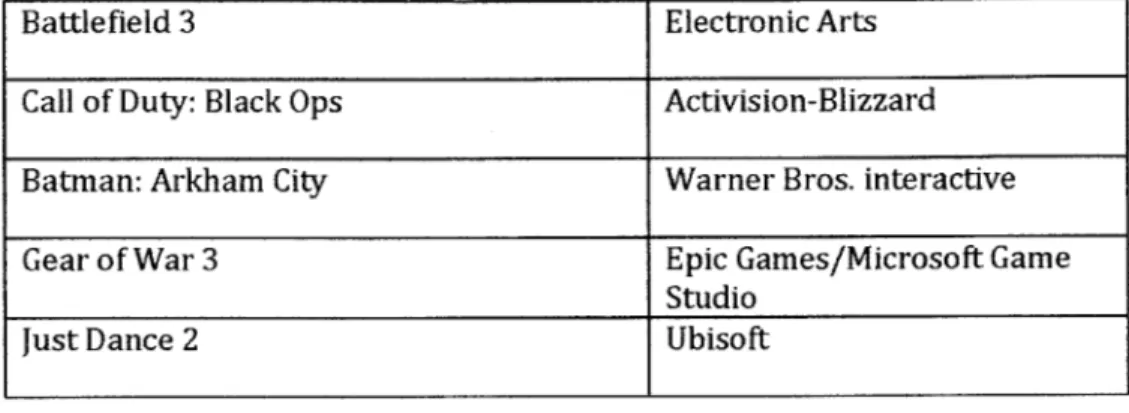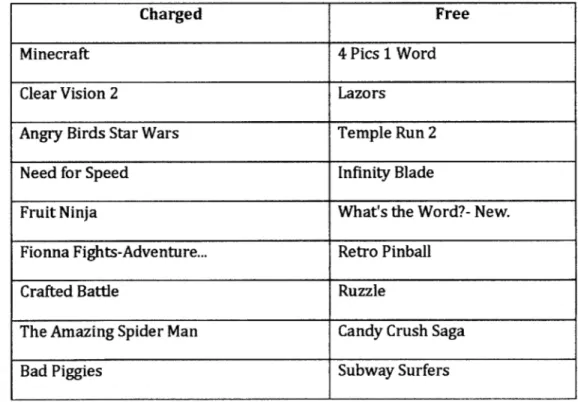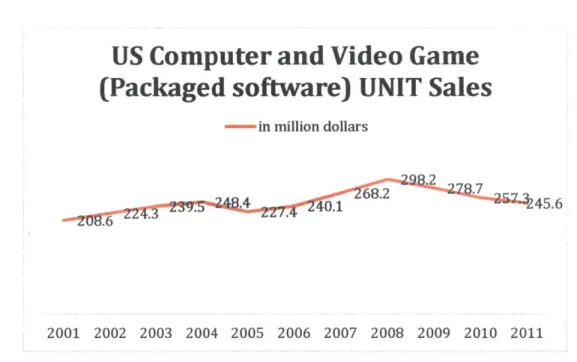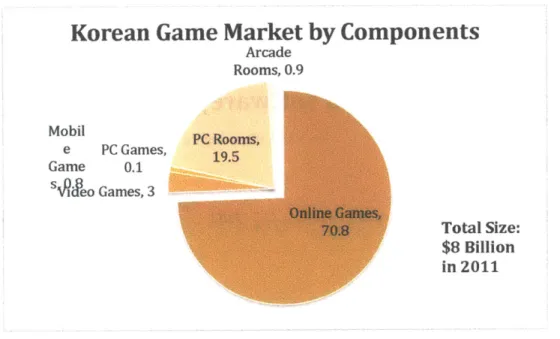Business Models and Strategies in the Video Game industry:
an analysis of Activision-Blizzard and Electronic Arts
ByRuri Lee
B.A. Art Studies, Hong Ik University, 2010
M.B.A. Sungkyunkwan University, 2013
SUBMITTED TO THE MIT SLOAN SCHOOL OF MANAGEMENT IN PARTIAL FULFILLMENT
OF THE REQUIREMENTS FOR THE DEGREE OF
MASTER OF SCIENCE IN MANAGEMENT STUDIES
ARCHIE
AT THE
MASCHUS IOE,MASSACHUSETTS INSTITUTE OF TECHNOLOGY
OF TECH NOGYJUNE 2013
MAY 3 0 2013
@2013 Ruri Lee. All rights reserved.
The author hereby grants to MIT permission
to reproduce
LIBRARIES
and to distribute publicly paper and electronic
copies of this thesis document in whole or in part
in any medium now known or hereafter created.
Signature of Author:
MIT Sloan School of Management
May 13, 2013
Certified by:
Michael A. Cusumano
SMR Distinguished Professor of Management
Thesis Supervisor
Accepted by:
(Michael
A. Cusumano
SMR Distinguished Professor of Management
Program Director, M.S. in Management Studies Program
MIT Sloan School of Management
Business Models and Strategies in the Video Game industry:
an analysis of Activision-Blizzard and Electronic Arts
By
Ruri Lee
Submitted to MIT Sloan School of Management
on May 13, 2013 in Partial Fulfillment of the
requirements for the Degree of Master of Science in
Management Studies.
ABSTRACT
In recent years the video game industry has been of great importance in the business world
beyond the role of a cultural medium. With its huge size and potential for more growth, the
industry has attracted many newcomers. The target customers are expanding to females
and elders who have not been known to be game players. Moreover, the introduction of
new platforms, personal computers and mobile devices, broadens the application of the
video games. Because of its diversified mechanisms and platforms, the business models of
the gaming industry have evolved. In this thesis, the traditional and newly invented
business models are introduced with an analysis of pros and cons through real cases of
gaming companies.
The analysis of Activision-Blizzard and Electronic Arts shows the current business
strategies of two giants in the industry, "diversification" and "casual games". Moreover, the
huge difference of financial performances of two companies indicates the risk of an
overbroad portfolio and investment in an unfamiliar genre.
Thesis Supervisor: Michael A. Cusumano
ACKLOWLEDGEMENT
First of all, I would like to thank my thesis advisor, Michael A Cusumano. His deep insight of
the industry has helped me to organize the thesis and understand the industry. His class,
"Advanced Strategy" inspired me to write the topic of the thesis and framed the contents.
His advice for the thesis has been great help for me to solve the challenges which I often
encountered during the process of the thesis. Moreover, his book, "Staying Power" gives me
a clear direction to the conclusion of the thesis.
In addition, I would appreciate people in the gaming industry. Due to the experience in the
Blizzard Entertainment as a member of the External Affair Team, I was fortune to meet
many various people in different positions and learned the practical knowledge about the
market. Moreover, through the indirect experience from the diverse people in the MIT, I
could acquire precious information regarding the industry.
Julia and Chanh have also helped me finalize the thesis with the countless support. Their
kindness and caring let me safely finish my thesis. Moreover, the MSMS students always
motivate me with their enormous enthusiasm. I was so lucky to be surrounded by the most
competent and enthusiastic people.
Lastly, I always appreciate my family to endlessly support my education and my future.
Without them, I could not be given any chances to study the field I love. Their belief in me
has been the most powerful driving force to successfully finish my education.
Contents
Chapter 1 Introduction ...
1
2.1. Historical changes in the gaming industry: from console games to mobile apps...3
2.2. The size, players and future of the gaming industry...
6
2.3. Attributes of Video Game Sales...
9
Chapter 3 Major Business Models of Video Games...
13
3.1. Packaged Game Software Sales ...
13
3.2. Subscription...
15
3.3. Free-To-Play Model...
16
3.3.1 Virtual Goods...
18
3.3.2 Freemium Services...
26
3.3.3 Advertisement ...
29
3.4 Other Business Models ...
31
3.4.1 Real Money Trading Auction House...
32
3.4.2 Electronic Sports...
34
Chapter 4. Business Strategies in the Video Game Industry: an Analysis of Two Players,
Activision-Blizzard and Electronic Arts ...
37
4.1. Activision-Blizzard ...
38
4.2. Electronic Arts...
40
4.3. The Trend of Business Strategy in Game Software Developers...
43
4.3.1 Aggressively expand to the global markets...
43
4.3.2 Diversifying service platforms beyond console games...
44
4.3.3 Extend the services to casual games including social games ...
45
4.3.4 Accept free-to-play models...
47
4.4. W hy Casual Games?...
48
4.5. Takeaways from the financial analysis of two companies' performances ...
50
Chapter 5 Conclusion...
53
Appendices (S&P Capital IP, 2013a; S&P Capital IP, 2013b) ...
56
1
Chapter 1 Introduction
Unlike the common perception of video games-that they are played by young, white who boys get
together and build "nerdy" cultures through video games-the video game industry has been the
major and most-profitable market in entertainment, aggressively expanding its customer pools
regardless of age, sex, and culture. Many people are even taking video games seriously in their
careers, in academic research, and in their personal lives. Critiques of video games as a negative
influence on children come up consistently whenever a violent incident occurs among teenagers.
Counter arguments are heard as well, insisting that video games do not affect teenagers'
perceptions of life nor their behavior. Regardless of the endless discussion of its impact, the video
games market is obviously treated as the hugest industry with the most potential, attracting
enormous capital investment and research. Through massive vertical integration from the small
game development studio to the professional management team, the video game industry is
significantly impacting global economies.
In this thesis, I would like to discuss the historical and current business models for video game with
a focus on software rather than hardware devices, and study the current trend of business
strategies through the analysis of the two biggest players in gaming software, Activision-Blizzard
and Electronic Arts. The major methodology is to acquire information mostly from current business
articles and analyze business cases from diverse game companies. My personal previous experience
in the video gaming industry contributes significantly to my understanding of the industry and
significant events in the industry. The industry report by Entertainment Software Association (ESA)
also contributes to my view of the broad picture of the market and history.
Although the video game industry never stops evolving, even by the minute, I hope that this research contributes to the understanding of the industry in a diverse perspective of the business model.
"It is critical that we sup port economic sectors that createjobs, develop innovative technologies and keep America competitive in the global marketplace. The video game industry is one of those
important, high-tech economic drivers. Our industry generates over $25 billion in annual revenue, and directly and indirectly employs more than 120,000 people with an average salary for direct employees of$90,000 (in 2001)." (Entertainment Software Association, 2012)
Chapter 2 Introduction of the Gaming Industry
2.1. Historical changes in the gaming industry: from console games to mobile apps
Throughout history, humankind has played games. Sometimes they play Chess, imagining warfare
in their territory; girls have played with dolls, dreaming about princesses and princes. Among all of
the types of games, the video game, defined as an interactive electronic game, was introduced very
recently. The first video game is known to be "Naught and Crosses" in 1951, developed by the
scientist named AS. Douglas working at Cambridge University(William H. Dutton, 2013).
After the first video game was developed, many electronic games were released. However, video
games didn't become truly popular with a mass audience from "Pong" (Chris Stokel-Walker, 2012),
created by Atari Inc., which developed an arcade version in 1972 and a home version in 1975.
(History ofgames - interactive timelinne ofgame histrory.2007) This table tennis-based game sold
with over 19,000 video game cabinets all around the world.
After the success of "Pong", the arcade game industry reached its peak in the late 1970s and early
1980s. "Spade Invaders" by Taito in 1978 led the industry further into the mainstream market, and
it sold in shopping malls, restaurants and convenience stores. In 1979, "Galaxian", developed by
Namco, sold over 40,000 units, and "Asteroids", released by Atari Inc., sold with 70,000 cabinets. In
1982, the arcade video game industry generated $8 billion in a quarter, surpassing the annual gross
revenue of both pop music ($4 billion) and Hollywood films ($3 billion) combined.
The era of video games has expanded exponentially from the time the 8-bit console game,
"Famicom", was released by Nintendo, bundled with "Super Mario Brothers" in 1985 (Alan
Maccormack, 2005). The next year, the release of the "Legend of Zelda" series and the "Dragon
Quest" series sparked huge public interest from around the world, creating an enormous number of
fandoms of Japanese culture that continues to thrive today. Also, the success of hand-held games, such as Game Boy by Nintendo in 1989, contributed to the growth of the video game industry. Beside console games, another major part of the video game industry is personal computer games. The early stages of the gaming industry were fully occupied with arcade games and video games. Computer games started getting attention with the penetration of personal computers. For example, the sales of Commodore 64, released in 1982 and breaking the price of $300, were a huge success with 22 million units sold, and this led to the development of computer games. At the same time, the leading arcade game company, Atari Inc., suffered from its underperformance with a $54 stock price plummeting to $35, after 8 years of continuous growth (Player 3 stage 6: The great videogame
Figure 1 Pong with Atari Developers
crash.1999). In addition, the adaptation of the computer mouse increased the convenience of
computer games, and the high-resolution bitmap enabled a high quality graphic-interface in the new release, boosting the popularity of the device (Commodore amiga 1000 computer.2006). With this new technology, the computer took up a significant portion of the industry. And with the introduction of the internet into households, computer games came into a new era: online games.
In 1989 and early 1990, MUD (Multiple User Dungeon) games gained in popularity among a small
number of internet users. In the game, users proceed to play the game with letter commands in the invisible set-dungeon. The popularity of MUD games led to the proliferation of graphic MUD and the
first MMORPG (Massive Multiple Online Role Playing Games), Ultima Online and Everquest. Released
in 1997 and 1999 respectively, the popularity of these two games opened the door for the creation of even more MMORPG games. In MMORPG, players connected to a persistent world, interacting with other massive players. Because of this characteristic, MMORPG players have different playing experiences than traditional console games, with either positive or negative interactions among the players. In the game, players typically join a Guild and combat other players, in a dynamic referred to as PVP (Player verses Player).
With the appearance of the internet, connecting players to players, the game service further expanded its possibilities in game playing. For example, RTS (Real Time Strategy), first designed in Dune II in 1992, created new cultures in game playing. RTS games require deeply involved
interaction between two participating teams (or two persons), as a two sided battled with limited
resources and territory. Its intensive playing style between two sides is similar to traditional
physical sports, and it later generated a new genre, E-sports, defined as Electronic Sports.
Currently, the hottest topic in the gaming industry is Mobile Games. With the huge adaptation of
smartphones and tablets, mobile games is gaining huge popularity even with electronic device
users who do not typically play console games or online games, which is usually a time-consuming
hobby. The best example of this phenomenon is Angry Birds, which was released in December 2009 and was the largest mobile app success in the world. This series of games has been downloaded 75 million times as of February 2011(erikheriksen, 2011) and had more than 1 billion download in 2012, generating profits higher than those of the average console and computer games (Rovio.com,
2013). The genre of mobile games was mostly limited to casual games such as tile-matching puzzles
smartphones and tablets, the genre of mobile games has been expanding exponentially. Mobile game users now enjoy MMORPG or RTS in mobile, which require high specifications of a device. Moreover, games which are released in computers and consoles were previously implemented in mobile. Because of its limitless possibilities and low development costs, an innovative future of mobile games is highly anticipated.
2.2. The size, players and future of the gaming industry
The gaming industry has not stopped growing since its inception, and now it is one of the biggest entertainment markets in history. In 2011, total consumer spending on the gaming industry reached $24.75 billion (Entertainment Software Association, 2013) while the gross revenue in Hollywood studios added up $10.2 billion in the same year (2011 market share and box office result by movie studio.2012). In consumer spending, computer and video game software sales in the USA accounted for $16.6 billion, the hugest portion of industry sales with 176.7% of growth for one decade from $6 billion in 2001 (Entertainment Software Association, 2013).
Figure 2 US Computer and Video Game Dollar Sales Growth (Entertainment Software Association, 2013)
US Computer and Video Game Dollar
Sales Growth
- In billion dollars
16.6
2001 2002 2003 2004 2005 2006 2007 2008 2009 2010 2011
The interesting fact about video game industry sales is that $7.3 billion of sales were from "other delivery format", defined as subscriptions, digital full games, digital add-on contents, mobile game apps, social network games and others differentiated from the traditional packaged game software sales. These have increased from $5.4 billion in 2009. At the same time, the sales from computer games and console games decreased to $9.25 billion from $10.58 billion in 2009 (Entertainment Software Association, 2013). This statistic illustrates changes in the gaming industry; the major portion of game players are moving to new formats of games, away from traditional package games for the computer or console. Another statistic regarding types of gaming devices also supported this new phenomenon; 58% of on-the-go players played the game with either smartphones or dedicated handheld systems in 2011 (Entertainment Software Association, 2013). The portion of users with wireless gaming devices has significantly increased from 37% in 2008 (Entertainment Software Association, 2010), and packaged game software sales in 2011 dropped 22% from the sales in 2008, when the revenues of sales reached its peak with $11.7 billion (Bloomsberg, 2012).
The growth of new game formats, however, does not mean that the gamers of console devices or of computer games have moved to new methods of games, causing package games to lose its
popularity. Sales of PlayStation 3 and Xbox 360 have fallen less than 10% showing that core gamers did not replace the way they play games with new devices (Bloomsberg, 2012). Although the
gamers of dedicated handhelds, where Nintendo dominates, are expected to replace their devices with smartphones, the gamers of other devices, including computers and console games, are still playing with their traditional game devices. In addition, the popularity of new games is related to the inflow of new users, especially female gamers. Unlike the stereotype that most gamers are young boys in a "geek" culture, a major portion of gamers are women over the age of 18, who
represent 30% of gamers. Boys ages 17 or younger make up 18% of gamers (Entertainment
Software Association, 2013). Moreover, the overall portion of female users has increased from 40% of all games in 2008 to 47% of all games in 2011.
Figure 3 the Portion of Female Users(Entertainment Software Association, 2013)
The portion of Female Users
48% 46% 44% 42% 40% 38% 36% 2008 2009 2010 2011
Considering that female gamers are likely to play casual games on mobile devices, the growing
popularity of "Other device format"' can be partly attributed to the new gamers who were
previously less attracted to game playing but then gained interest because of the new design of
games in new devices. To sum up, the future of "Other device format" of games, especially mobile
apps, are expected to be expanded.
2.3. Attributes of Video Game Sales
The traditional video game industry has many similarities with the movie industry; the sales of
video game software vary considerably across titles with few blockbusters. In 1998, just 10% of all
games released made a profit, while half of them sold less than 10,000 copies (Peter Coughlan,
2000). The bestselling titles generate more than one-third of all sales in the industry, returning up
to 30 times its development cost (Alan Maccormack, 2005). Megahit titles usually lead to highly
profitable sequels. In 2011, among the 10 top selling video games, all of the best sellers were
sequels from previous megahits except one title, "Batman: Arkham City" (ranked seventh).
Computer games experienced the same phenomena; all of 10 top selling games of 2011 were in a
series from previous titles except "Star Wars: The Old Republic", which ranked in first
Figure 4 Top 10 Selling Video Games of 2011(Entertainment Software Association, 2012)
Game Titles
Developer/Distributor
Call of Duty: Modern Warfare 3
Activision-Blizzard
Just Dance 3
Ubisoft
Madden NFL 12
Electronic Arts
Elder Scrolls V: Skyrim
Bethesda Softworks
1 Term used in "Essential Facts about Computer and Video Industry", 2012, p12: Other delivery format include subscription, digital full games, digital add-on content, mobile apps, social network gaming and other physical delivery
Battlefield 3 Electronic Arts
Call of Duty: Black Ops Activision-Blizzard
Batman: Arkham City Warner Bros. interactive
Gear of War 3 Epic Games/Microsoft Game
Studio
Just Dance 2 Ubisoft
Figure 5 Top 10 Selling Video Games of 2011
Game Titles Developer/Distributor
Star Wars: The Old Republic Electronic Arts
Elder Scrolls B: Skyrim Bethesda Softworks
StarCraft II: Wing of Liberty Activision-Blizzard
The Sims 3 Electronic Arts
World of Warcraft: Cataclysm Activision-Blizzard
Battlefield 3 Electronic Arts
The Sims 3: Generations Electronic Arts
The Sims: Medieval Electronic Arts
The Sims 3: Pets Electronic Arts
Considering that new titles "Batman" and "Star Wars" originated from blockbuster movie hits with
huge licensing costs, it is obvious that the new titles from small companies with limited funds
would have a very difficult time competing with a "megahit" series. "Batman" and "Star Wars" were
published by the biggest game companies, Warner Bros., Interactive Entertainment and Electronic
Arts, respectively. Additionally, the nature of the gaming industry requires the escalating cost of
development and marketing so that large and well-capitalized companies with a long record of
commented, "With 5,000 titles being published every year, to play in the top 10 requires $5 million
in marketing. It's hard to take that kind of risk with new games, and few companies will be able
to."(Entertainment Software Association, 2013).
For console games, the introduction of new console devices governs the sales of software. The sale
of consoles reaches its peak when the device is first introduced and then declines when market
penetration meets its peak and a new generation expected. The pricing of game software is also
related to the sales of console devices. With the new generation of console, software can maximize
the price of games and it lasts several years, usually three to five years. However, when the release
of a new generation of console is anticipated, the sale of software with the current device weakens
with a lower price.
Computer games software is influenced by the penetration of broadband internet and the personal
computer. In South Korea, the portion of online games sales accounted for around 70% in 2011
while console games sold made up just 3% of sales in the game industry (Korea Creative Contents
Agency, 2012). Many experts believe that this resulted from the synergy between the popularity of
gaming and the high-speed access, as Korea ranked high in its internet penetration rate in the world,
82.7% (Internet worlds stats2013). In a similar way, the countries with higher broadband
penetration, including northern European countries and western European countries, are likely to
play online games rather than console games. However, Japan and the US, with high internet
penetration, were known as the hub of console games, showing that high correlations between the
internet and online games are highly positive but not dominating.
On the other hand, the App games market shows a different aspect of the industry than the
traditional game market App games require relatively short production and marketing costs since
most app games are casual games. According to the report "How much does it cost to develop an
app" by BlueCloudSolutions (Carter Thomas, 2012), Angry Birds, the biggest megahit, generated
more than $50million, and cost $125,000 to $180,000 to develop, an incredible ROI. The
development costs for a game app varies based on the mechanism of games and the graphic design; casual games cost less than 3D graphic based Role-Playing Games. However, the opportunity of app games for small companies is significantly wider than that of console and computer games. Among the top 10 games in the USA App Store, in the third week of February 2013 (Lee Eun Byul, 2013), most games were developed by unknown small companies, although some of them were published
by big companies such as Electronic Arts, Mojang, and Rovio Entertainment The sales of app games
depends on user experience and word-of-mouth, so that the development companies can find more opportunities for success with fewer risk and costs. However, because of an easy entrance into the market, the competition in app games is very intense with more than 100 games released daily.
Figure 6 Top 10 games in the USA App Store in February 2013
Charged Free
Minecraft 4 Pics 1 Word
Clear Vision 2 Lazors
Angry Birds Star Wars Temple Run 2
Need for Speed Infinity Blade
Fruit Ninja What's the Word?- New.
Fionna Fights-Adventure... Retro Pinball
Crafted Battle Ruzzle
The Amazing Spider Man Candy Crush Saga
Chapter 3 Major Business Models of Video Games
3.1. Packaged Game Software Sales
From the cartridge to Game Boys in the 1980s, to the CD format to the most advanced Play-station
and Xbox 360s, "packaged game software sales" is the oldest and the most used business strategy
for video game companies. Packaged game software is the medium containing game contents.
Usually the content consists of one game plot and design that customers play anywhere from 10 to
30 hours. The players purchase the titles within a diverse medium matched with game play devices
including early Game Boys, game consoles, personal computers and, nowadays, smartphones. For
example, a user who owns a PlayStation 3 buys a newly released title, "Assassin Creed", in the
format of an exclusive PlayStation CD. The logic for this business model is very simple; the users
pay the initial license fee upfront and own the right to obtain the service in perpetuity. This simple
business model has been loved by most of game companies due to its simplicity and efficiency. This
business model is also easily combined with other models, in particular Micro Transaction. For
example, in "Guild War 2" developed by NCSoft in 2012, players buy a standard $60 title. However,
for supplementary services, such as transferring to another server or changing the characters'
appearance, players must pay additional fees. According to research conducted by ESA, the sales of
physical game software have decreased in recent years. The decline in sales may be due to diverse
channels to buy the software and little diffusion of packaged game fans to free-to-play games.
Figure 7 US Computer and Video Game (Packaged Software) UNIT Sales (Entertainment Software Association, 2013)
US Computer and Video Game
(Packaged software) UNIT Sales
- in million dollars
.4 6.2 9 J 45.6
2001 2002 2003 2004 2005 2006 2007 2008 2009 2010 2011
Although the most intuitive business model, "packaged game software sales" still prevails in the gaming industry, it failed to succeed in specific markets because of illegal replicas. South Korea, one of the most developed video game markets with a 18.9% growth rate in 2011 (Korea Creative Contents Agency, 2012), is the leader in the gaming industry with extraordinary characteristics, such as the prevalence of the PC Caf6 culture and the national-wide popularity of E-sports. In early
1990, most Korean gamers enjoyed packaged game software. However, because illegal replicas of
games soared among gamers, most Korean game developers went bankrupt or changed their type
of business to online services. Currently, the sales of packaged video games account for just 3% of
the approximately $9 billion Korean gaming market (Korea Creative Contents Agency, 2012). Now, most Korean game companies provide online games applying a subscription model or PC cafe sales as business models, which occupied 70.8% and 19.5% of sales in total market size respectively [See Figure 7].
Figure 8 Korean Game Market by Component in 2011 (Korea Creative Contents Agency, 2012)
Korean Game Market by Components
Arcade Rooms, 0.9 Mobil PC Rooms, e PC Games, 19.5 Game 0.1 s eo Games, 3 Total Size: $8 Billion in 2011 3.2. Subscription
For certain genres of game, such as MMORPGs, the investment into game development is
substantial, averaging hundreds of million dollars. For big titles, the developers invested as much as a Hollywood movie shooting. For instance, Electronic Arts spent $200 million developing "Star Wars: Old Republic" released in December 2011 (Eddie Makuch, 2012). In addition, investment for service management is added up for servers, customer services in call-center, and contents updated. At the same time, the lifecycle of game playing is expected to be longer than package game software.
For the early and middle stages of content, the gamers' experiences are almost the same as traditional package role-playing games. However, when gamers reach a certain level in the game, they are involved in endless end-game content, such as the production of game items or battles with
players, called PVP. Continuous interaction with other players in coordination with or in battle with increases the player's willingness to pay for the game. Because of these reasons, MMORPG
developers have opted for subscriptions to generate profits instead of upfront license payment for the game. The subscription business model in the gaming industry is nothing new; players pay a
recurring monthly game service fee. The payment amount varies between game titles. Currently, "World of Warcraft", which recorded the largest active subscribers in gaming history (12 million worldwide in 201), charges $14 per a month.
The subscription business model earned popularity among developers because of continuous revenue generation and players' high willingness to pay. However, as the competition in the MMORPG market is getting so intense, many game services switch to a free mode with a micro-transaction revenue model. For example, "Aion", which ranked second in xfire.com(xfire, 2013) in October 2009, changed its business model from a subscription based model to a free-to-play with virtual goods model in February 2012 (Aion, 2012). Before "Aion", "The Lord of Rings" and
"Dungeons and Dragons" also changed their business models to free-to-play with virtual goods shops in 2009 and 2010 respectively. On the other hand, traditionally successful games also
implemented a partial free model; "World of Warcraft" provides free service to beginners until they achieve level 20 to attract new players, and "Star Wars: Old Republic" also offers free story content but charges for additional end-game content
3.3. Free-To-Play Model
Thanks to intense competition in the gaming industry, many game services have adopted or
switched to a free-to-pay model to attract more players from competitors. Moreover, the increasing social-media games based on existing social network systems actively offer their services for free to expand their user pools and charge additional services for easier game play. The fact that casual
gamers from social network games and mobile app games are less willing to pay for subscription or
fees upfront also supports the popularity of the business model.
At the same time, core game developers, especially in MMORPGs, found that many players are likely
to pay more for the game to outfit their avatar with better weapons than other players in the virtual
world. Therefore, many of them contacted other players or "Game Gold Farmers" to buy strong
equipment for characters or in-game gold. According to BBC News, research by Manchester
University shows that more than 400,000 people, 80% based in China and the rest in developing
countries, earn an average of $145 per a month from gold farming and the total global market for
in-game gold farming was $500million, with the fact that the market is hard to estimate
-
"it could
easily be twice as big" (Poor earning virtual gaming gold.2008). Considering basic demand-supply
relationships, the players' willingness to buy in-game items with real money was significantly high.
Consequently, developers are required to choose "losing revenue" in game services. '
The final reason to adopt a "free-to-play" model is caused by game design. For most
online-connected games, the game design is highly dependent on the existence of other players. For social
games, without friends who play together, game users easily lose their interests. As "First-Shoot
Person" or "Real-time Strategy" games require having opponents all the time, no players are willing
to wait to find opponents in the waiting screen. For MMORPGs, the large player pool is significantly
important In the early and middle stages of content, players can enjoy "solo" playing, focusing on
leveling-up. At that time, the content is similar to console games. However, end-content mostly
consists of group content requiring 5 to 100 players for activities such as warfare between players
(Thomas Debeauvais, 2012). Therefore, a certain number of players should be kept in the game
services. This is the reason why game developers offer free game services to attract more players.
In free-to-play games, the revenue is mostly generated by real-money transactions,
defined as
players buying in-game services with real money. In this model, players buy virtual goods to
enhance the quality of the game experiences, or they are provided with the initial stage of games for
free and then required to purchase advanced functions or game services. Many casual games, especially in portal sites, are provided for free and generate revenue by advertisement like traditional internet services. Below, the details of each subcategory are discussed.
3.3.1 Virtual Goods
The business model of virtual goods emerged in the very early internet era. However, the
popularity exploded during the last couple of years with the emergence of social games and mobile apps games. Generally, virtualgoods is defined as the properties in virtual and electronic worlds. For instance, objects in the game such as characters, items, currencies or tokens are examples of virtual goods which are traded (Vii Lenhdonvirta, 2009). There are differences between information
goods and virtual goods since virtual goods are exclusively used by a person when information
goods are not (Vii Lenhdonvirta, 2009). To be specific, a game item belongs to a player excluding others' same item usage. However, a user is able to send an MP3 file to other friends if he decides to ignore the legal rights approval. The meaning of virtual goods often includes the transactions between players and players, or players and gold farmers who specialize in earning in-game gold and selling it to other players. Most game companies regulate the transactions between players and gold-famers, as the black market for gold usually ruins the economy of a virtual world. However, the market for gold farming has dramatically increased over the past several years. This has been the main reason why game developers provide game services for free and sell game items in online shops instead of applying a subscription fee. In this type of session, virtualgoods is defined as the transaction between the game company and the players; the one-way transaction of goods from the company to the players.
Among the free-to-play business model, "Virtual Goods" is the most widely accepted method in a variety games. Most social games and mobile app games adopt "Virtual Goods", and many
MMORPRGs have also switched to the system. This model is sometimes used as a complement to a traditional model, an upfront purchase model or a subscription model. In "World of Warcraft" which has kept its subscription model, the micro-transactions for Virtual Goods was recently introduced; the players who are already enrolled via subscription can buy "pets" for pure pleasure (the pet does not affect any game play experiences but look adorable). Or they can purchase additional game services, such as transferring a server or changing an avatar's appearance. In 2012, the Virtual Goods market amounted to $2.2 billion (Justin Smith, 2011). The business model has been widely implemented from social network applications, mobile game apps, casual and hardcore MMOs, and even some console games. Social network applications, mostly on
Facebook, counted for more than half of the revenue generated, $1.2 billion, with approximately 20% growth rate from $835 million in the previous year of 2010 (Eric Eldon, 2011). According to
emarketer.com, Virtual Goods are the main revenue source for social games with a 60% share,
followed by 26% from lead generations and 14% from advertisements (Samuel Greengard, 2011).
Sales of Virtual Goods in mobile apps are also continuing their growth with $350 million in sales in
2011 (Eric Eldon, 2011). MMORPGs traditionally adopted subscription models have rapidly
changed their revenue sources to Virtual Goods. According to the developer of "Puzzle Pirate", the game has earned $50 per month from each playing user (Paul Hyman, 2009). Although he revealed
that just 10% of players are paying for game playing, the earning is even significantly higher than
the traditional subscription fee for "World of Warcraft", which has been $14.55.
The range of Virtual Goods has expanded to cover all parts of game services. Below are the major types of Virtual Goods.
Time Reduction
For some game services, especially in social games, the players must wait for a certain amount of time to achieve quests. For example, in Zynga's "FarmVille", players have to wait from several
minutes to days to complete the building constructions and to get action point to practice a
behavior such as farming or hunting. Players are able to acquire additional action points or reduce their waiting time when they refer the game to their friends or, mostly, when they purchase points. Another case is "Anipang" in KakaoTalk, the most used mobile messaging application in South Korea. The game bought was hugely popular in South Korea with the function of a ladder linked that to KakaoTalk friends' contacts. In the game, players are given a certain amount of 'Hearts" which are reduced per a game and the "Heart" is refilled every 8 minutes. To get a "Heart", players can purchase it, refer a friend, or ask to their friends to send it.
Figure 9 Anipang Screens (SundayToz inc, 2013)
Because of the linked ladder and the "Heart" system, the players are addicted to the game and
purchase "Hearts" to play more. Although the mechanics of the game itself are very simple, a
traditional Hexa design matching the same three or four tiles, the game has recorded 10 million
plays per a day, and averaging 54 minutes of play time per a player every day (Evan Ramstad,
2012). It is true that the
time reduction model
for virtual goods works very well for social gameswith a simple design. In addition, for games with more sophisticated designs, time reduction is also
Strategy games with "Aeon of Strife" styles, players can buy boosts to secure their level-up. When
they achieve every level-up, they can passively enhance their game avatars with "Lune" and
"Materials", making faster level-up very crucial to the game playing. LOL Players are not required to
purchase any Virtual Goods to level up at all, but with boosts, they can attain it with very faster pace
and enjoy better game experiences. LOL also implements interesting virtual goods items
-champions purchase. In the game, -champions refers to a variety of avatars having different skills
and battle styles. Champions rotate weekly for free so that users can choose weekly champions to
play the game without any inconveniences. However, some players might hope to possess a
champion to play it whenever he would like to. In that case, the player can purchase a champion
either with real money or by points earned in game play. In short, virtual goods for champions can
reduce the waiting time for certain champions and give the freedom to enjoy a champion whenever
they want to.
Functional Enhancement
In video games, most players spend their money to be better or stronger than other players. For
MMOPRGs, to have stronger avatars very directly influences the game experience; one can easily
defeat his opponent, usually other player, receiving high levels of satisfaction and feeling proud of
himself. Therefore, the history of a transaction of game items among players has been simultaneous
with the history of MMORPRGs. As mentioned above, the gold farming market is assumed to be
$500 million, according to research by Manchester University (Poor earning virtual gaming
gold.2008). In order to keep up with strong demand from players, game companies provide virtual
goods to enhance the characters' performance in terms of attire, weapons, or potions. In "Maple
Story", a casual MMORPG game mostly targeting youth, players are given an online cash shop to buy
weapons, potions and even strong avatars. Although the virtual goods for enhancement is present
mostly in MMORPGs, other genres of games also adopted the same principles. Kart Rider, a racing
game developed by a Korean game company, Nexon, provides users the online cash items, including faster vehicles or items, to hinder others' racing. The game employs a two-currency system; less stronger and basic items can be purchased with real money, and the strongest items are only bought with the points earned from game play (Vii Lenhdonvirta, 2009).
Despite the popularity of functional virtual goods, some games failed to lead to success. In 2004, when Electronic Arts introduced a new system to the historic game Ultima Online, the "Advanced Character Token" system that switched the low-level avatars to high-level ones, the response from players were very negative. The system actually sold mediocre avatars and not the strongest ones, failing to provide full satisfaction to the users (Vii Lenhdonvirta, 2009). At the same time, some people criticize the fact that a virtual goods system is able to destroy the ecosystem and the balance in the virtual world. Players with money can easily achieve a higher level of game experiences without substantial and time consuming efforts. Regarding "Maple Story", it has been criticized that a player without virtual goods is almost unable to defeat virtual goods avatars and the game
induces conflict between major players, youth, and parents. Since some players cannot afford desired items, they appeal for money to parents or even steal money from parents to buy those virtual goods.
Aesthetic Goods
Some virtual goods do not offer any functional impact, but merely satisfy players; these items
please players' aesthetic tastes. Most game players in the internet world share a similar
characteristic; they want to differentiate themselves from other players. Consequently, from the early internet era, mainstream online sites have implemented aesthetic aspects into the system providing avatars or room decoration systems for users' own accounts. The video game companies also utilize the same principle in the game systems. Many casual games provide avatar systems so that players can beautify their avatars with the points earned by game play or real money. For
MMORPGs, players are given chances to buy avatars attire inspired by famous celebrities or seasonal events (e.g. Chinese Lunar New Year, Halloween). "Aion" seasonally introduces outfits
relevant to certain celebrities who are usually the promotional models for "Aion" and players can attain additional behaviors within the dresses, such as dancing or singing. On the other hand, "League of Legends" has succeeded its sales of skins that do not affect any game experiences but change the attires of characters in game play. Most social games, including "Second Life" or "Sims
Series", also utilize aesthetic items to provide diverse outfits to the users.
Additional Features
For many MMORPGs, the virtual goods system is the complementary revenue resource next to original business models, an upfront fee model or a subscription model. Many of them utilize the kinds of virtual goods mentioned above, but most charge for additional features instead of core
items. "World of Warcraft" adheres to the subscription model for its revenue source. However, when the player chooses to take services that are not essential services of the game, the player must pay for them. Examples include a server transition, a name change, an avatar appearance
modification. Most game companies apply the same charge for supplementary services in a similar way.
Figure 10 Additional Services in WOW (Blizzard Entertainment, 2013)
0
World of Warcraft@: Mists of PandariaDownload Game Uient
UCharacter
TransferRac e Change
50
Guild Aaster ServicesFl ree Character Migration
APPearance Change
*faFaction Change
Minage Change
Kompu Gacha Items
On May 9, 2012, major Japanese social or mobile app-game companies, including GREE, DeNA, Miki and CyberAgent, announced that they would get rid of all Kompu Gacha items in their game services according to the industry watcher Dr. Serkan Toto. After the announcement, GREE and DeNA, the biggest mobile app game companies, experienced more than a 20% decrease of their market value (Kathleen De Vere, 2012). Kompu Gacha, which has had a large impact on the gaming industry with its lenient regulations, is explained with the game mechanism that an item brings out a random item including any game items, in-game currencies, and, very seldom, extremely valuable items. The mechanism of the item-outcomes is similar to a gambling vending machine with the "gacha"
Figure 11 Kompu Gacha Item Mechanism (Kathleen De Vere, 2012)
--
Kompu gacha' game example
Item A Item B Item C Item D
Grand
prizeThe positive aspect of the item is that it can bring a new dynamic to the game play, and, of course, generate more revenue since many players are likely to be addicted to the randomized outcomes. However, because of its speculative traits, Kompu Gacha has always been controversial. According to the Japanese Consumer Affairs Agency, parents submitted 688 complaints to the agency about Gacha between April 2011 and March 2012. One case, for example, saw a boy in middle school spend more than $5,000 for Gacha items in a month (Kathleen De Vere, 2012). This was the reason the Japanese government decided that Komppu Gacha items had the feature of lucrative speculation, leading companies to ban the implementation of the system.
In South Korea, one of the most developed game-playing countries, the random "Mysterious Box" implementing the same mechanisms of Kompu Gacha has been a hotly debated issue. Especially after the Gacha regulation in Japan, the relevant agencies in South Korea have focused on the issue of random items. However, a regulation is not expected to be employed in the near future because
of the implementation of other regulations such as the "Shut-down" policy.2 It is obvious that this new form of virtual goods has earned a huge amount of money for these companies, but developers should keep in mind the boundary between "games" and "gambling".
3.3.2 Freemium Services
The Freemium Service is a widely used business model in internet software and applications. The
basic idea is that the developers provide a free service in the initial stage of the software (limited to
the function or the usage time) and the users can decide whether they would like to purchase it for further usages. Most software companies utilize this model; Adobe provides a 30 day free trial version and users can buy it after fully enjoying the free version. When the computer software mostly applies a time-limited freemium version, many mobile applications and internet sites employ the function-limited freemium. "Period Tracker", which helps women simply track their period circulations and has earned 24,996 ratings so far (in Google play as of April 18.\, 2013) (GP International, 2013), has a light version for free and charges for a "Deluxe" version with more decorative functions for $1.99. Among the internet sites, Linkedin.com most actively employs the freemium version. The world's biggest "professional network" with more than 200 million members (Linkedin.com, 2013), LinkedIn offers a free service to people to upload professional information to their walls. However, the more users pay, the more detailed information of others they can search. In addition, the users are able to upgrade the number of In-mail messages to get introduced to inside sources at companies through LinkedIn connections. More services are provided to charged users.
In the gaming industry, vendors usually apply the function-limited freemium like Linkedln.com, rather than the time-limited freemium used by Adobe. In addition to the virtual goods sales, free
2 "Shut-down" policy means the regulation requires game companies to "Shut-down" their game services to
MMORPGs, especially those that have switched from subscription to free-to-play, provide advanced
services for a charge. The "Star Wars: Old Republic" switched to a free pricing model to attract more
players. However, the developers differentiate users by those who subscribe, those who have spent
more than $4.99 so far, and those who play for free without any payments. According to the money
spent, the users are provided different levels of game features
-
for free users, they can just
"World of Warcraft" also recently implemented the Freemium version providing free services until
level 20 (the maximum level is 90). The Freemium revenue model is attractive in terms of a new
inflow of users, but how many people will remain after the free service is still questionable.
3.3.3 Advertisement
Advertisements have been one of the most popularly used forms of revenue sources in all types of
media. Most newspaper and TV broadcasting companies rely heavily on advertisements as a major
revenue resource. Recently, the fragmentation of traditional media and the popularity of the
internet have contributed to the focus of ad placement shifting to the online platform. In 2011, the
revenue from the online advertisements totaled $31.7 billion, 21.9% higher than the previous year
(PWC, 2012). The revenue from advertisements in video games has also increased; it was
anticipated to reach $650 million in 2012, increased from $295 million in 2007, according to report
by Park Associates (Melissa Campanelli, 2012). However, the most effective mechanism of
advertising placement in games is still in discussion because the impact on game revenue is not
significant
Advertisement in games is categorized into two types; the first is the banner advertisement (banner
ads) and the second type is the in-game advertisement (in-ganie ads). The banner-ad refers to an
advertisement placed in the page of a game's homepage. For instance, Pogo.com offers over 100
casual games for free with banner-ad sponsorship. When players enter the Pogo homepage, they
are exposed to advertisements on screen in every step of the process to reach a game. The
background of the main site is assigned to the advertisement, and, needless to say, the
advertisement is also placed in the center of homepage.
Figure 13 Pogo.com Screenshot
3rs
Onuner erii_S
US)P CA
0
Car Wore Casino Arcade Hiddan OtjecA , Club POo More
Games a Games Games Games Games Gamnes Games
All Games > Puzzle Games
- A Pcg C s u The thin light & portable
P lay ter ,. s seon r ar tablet from Google.
-,aloos to release priCes.
ne- us,
BejewIed 3
_Z_
, 1,classic made version of-kthe rc stspopular puzzle
Bejeweled Twist ane ot cntr
Spin -natcM. explode! Bejeweled Twist is a rilliant new wai to pla
Gelewele'
The business strategy with a banner advertisement is compatible with the characteristic of games provided by Pogo.com. All of the more than 100 games are casual games, such as puzzle games, board games and card games. Because the games are based on the web-screen rather than exclusive game client software, the banners are well matched to the web screens. Moreover, the willingness to pay for casual games is relatively lower than hardcore games. Therefore, although the users are exposed to advertisement during every moment of game plying, they do not consider it as deceptive or irritating since these are free games.
The second type of ad, the in-game advertisement, refers to the placement of a brand in a game. Developers manage efficient advertising placement with an auction system, like Facebook or Google, through the ad-placement devoted site, www.secondads.com. In FIFA online, for example, players are exposed to a Nike advertisement placed along the in-game stadium fences, similar to a real soccer stadium. In Second Life, players experience products that are promoted in the game in the form of daily-used products in virtual worlds, such as clothes, stores, beverages, posters or a banner on the wall. For in-game advertisement placement, the players' attention matters for
efficiency and payment from advertisers. Players' attention is likely to go to the main game contents and advertising information gets secondary notice. Therefore, attracting attention from players is the key to the success of the in-game advertisement
Figure 14 Ad placement in Second Life (SARAH WHEATON, 2007)
3.4 Other Business Models
Besides the major business models, gaming companies have also created diverse business models
and applied these to their game services. These business models are not universally applicable
since these are developed for the unique characteristics of the game services. Below is an example
3.4.1 Real Money Trading Auction House
When Blizzard announced that the new Diablo 3 (Blizzard Entertainment, 2011a), a series of
successful Diablo sequels, contained a Real Money Trading Auction House (called RMT Auction), the news shocked many gamers and the gaming industry. An auction house within the game service is not a new idea at all. Most action games or MMORPGs implement an auction house in order to enhance transactions between players. Auction houses in the game have a function similar to a real auction house in the offline world; players place items in the auction and buyers bid for the item, or they can buy an item immediately if they pay the price sellers want The auction house regulates the inflation in the game and provides additional fun to the players by encouraging them to get involved in item generations and transactions. However, the huge difference between the traditional auction house of other games and of Diablo3 is that players can deal with real, offline money, such as dollars and euros. In Diablo3, players are required to choose a currency, whether in-game money currency or real money, when they access the auction house.
The Diablo series has been well known for its active item transactions compared to the early series. Because the game experience significantly varies up to the levels of weapon, and the items are randomly dropped from monsters, most players spend massive amounts of time hunting monsters while waiting for high level weapons. Therefore, many players who do not want to spend their time on the random possibility of weapons, and instead chose to buy items from other players with real
money. The market for Diablo 2 items was too large to measure, and many players have complained
that they became addicted to playing the game due to the game's item dropping and the potential of items as real money.
It can be interpreted that the purpose of Blizzard having RMT auction house is that the company is able to maintain the item transaction fee, which usually goes to the third parties. In the Diablo 3 auction house, the price is subject to a $1 fee charge for an equipment item (weapon, armor, accessories, and other unique items), and 15% of the final sales price for commodities (gems,
materials, dyes, pages, recipes, and other non-unique items) (Blizzard Entertainment, 2011b) with
a maximum price of $250. Moreover, since the company can manage and record transactions, it can
more accurately understand the economy of in-game placements and regulate cash flow. Players
also can rely on transactions since the game host manages the transaction themselves. They do not
need to use illegal third parties and risk being deceived by them. After the system had been
successfully applied in most of countries, the South Korean government did not approve the auction
house in the Korean-server, saying that the system contained the speculative traits, meaning that it
could be played as a gambling game.
Blizzard Entertainment did not announce the financial impact of the RMT auction house. However,
many people suspect that Blizzard earned significant revenue from the transaction fees of the RMT
auction house, as the deals in the auction have been very active. Though the RMT auction is not
applicable in the every game system, it is required to solve many issues such as regulations and
taxations. However, if applicable, the business model is definitely attractive with minimum effort
and huge impacts.
Figure 15 Diablo3 Auction House (Blizzard Entertainment, 2011b)
3.4.2 Electronic Sports
Electronic sports refers to professional gaming; game playing between two opponents (individuals or teams), having similar traits to traditional sports games, such as competitiveness, winners and losers, and multiple object tracking. In 1980, the first electronic sports game (called e-Sports) was played in the Space Invaders Tournament by Atari. It was first recorded in the e-sports event through electronic devices. Since the 1990s, the arcade gaming scene has mostly focused on fighting games, as well as bullet hell shooter games and rhythm music video games in more recent years. The mass popularity of e-sports began with Doom I & II, Quake. Electronic sports continued to succeed in the 20th century, the timing being aligned with the penetration of the internet and online games, with global tournaments, such as Major League Gaming (MLG), Global Starcraft League
(GSL), World Cyber Games (WCG), Dreamhack, and Intel Extreme Master. Among many game
(FPS), Massive Multiplayer Online (MMO) and Racing. In particular, RTSs, such as Starcraft and
Warcraft Ill, are played professionally, while finals matches for Starcraft are spectated by tens of
thousands of fans. FPSs, such as Halo, have a large professional base as well. In MLG (Major League
Gaming) in America, the most popular game of e-sports is Halo. Currently Dota and LoL are both
extremely popular for professional competition as well.
The way to generate revenue from popular e-Sports is not clear yet Most shows and tournaments
are provided for free to speculators and they are mostly used for marketing purposes rather than
revenue generation. In South Korea, where e-Sports have enjoyed nationwide popularity with
sponsorship from the government and an e-Sports specialized cable channel, the Korean e-Sports
association (called Kespa), had conflict with Blizzard Entertainment regarding ownership of the
game service property and whether it is common property like other sports or the property of a
company.
As shown above, when the property of a game such as the e-Sports genre is not specified, the revenue generation from the e-Sports game itself is hard to predict for the game companies. However, many people, including pro-gamers, show anchors, show broadcasters, and team
management teams, are involved in e-Sports tournaments and shows, which has led to job creation, and individual internet showcases are active in giving revenues to show hosts. Slight revenue is also being generated with marketing effects. Barcraft, occasionally hosted by Blizzard, shows the best
example of how a company can induce the effect of e-Sports. Combined with traditional sports bars,
Figure 16 Barcraft in Washington, D.C. (Barcraft, 2013)
Although the clear business model to the companies is not suggested, the current popularity and future of e-Sports are indisputable and this trend forms the huge global industry with diverse stakeholders. Therefore, the potential for revenue generation is also expected after careful discussion of the current issues.
Chapter 4. Business Strategies in the Video Game Industry: an
Analysis of Two Players, Activision-Blizzard and Electronic Arts
In the mid-1980s, the game industry grew exponentially with the popularity of console game
devices. The nineties was the time for console makers to experience not only further enormous
growth in the video game industry, but also strong competition with new entrants into the market,
Microsoft with Xbox and Nintendo's Wii, which opened a new era of a console game mechanism
with movement-detective functionality applied in an innovative game experience.
However, recently the emphasis on the game industry has been moving away from console makers
and toward software developers due to diversified game platforms, including personal computers
and mobiles. The total market size for the game industry is also strongly dependent on the sale of
game software. In 2011, game software accounted for 66.8% of sales, $16.54 billion out of a total
$24.75 billion total customers spending on the games industry, while hardware sales amounted to
$5.58 billion (Entertainment Software Association, 2013). The huge sale of content added to the
significance of its sales size in the game market.
In this chapter, the movement toward game software business strategies and revenue models is
discussed via the comparison of two major players, Activision-Blizzard and Electronic Arts.
Furthermore, the new trend of casual games is analyzed in terms of its advantages and its impact on
the overall game industry.
Figure 17 US Computer and Video Game Dollar Sales by Components (Entertainment Software Association, 2013)
US Computer and Video Game
Dollar Sales by Components
* Hardware
a
Accessories ContentIn billion
15.9 16.54
2010 2011
4.1. Activision-Blizzard
Located in Santa Monica, California with 7,300 employees as of December 31, 2011 (MarketLine,
2012a), Activision-Blizzard is one of the biggest game developers in the world. Merged in 2008 by
Vivendi Games, the French game developer and publisher, the company still exists as separate
entities, Activision and Blizzard Entertainment, and each publishes games in their own names.
The company has shown strong financial statements for the last several years. In 2011, revenue
from digital channels recorded $1.6 million with $4,755 million net revenue and 30.3% of operating
margin (Activision Blizzard, 2012). The company possesses $3.5 billion in total cash and
investment without long term debt Moreover, it has shown very strong capital returns to
shareholders, $3.1bilion with a 96% payout ratio and $3.3 billion in free-cash flow, from 2009 to
2011 (Activision Blizzard, 2012). A huge portion of the revenues comes from international sales.
With a strong financial status and stable revenues from global markets, Activision-Blizzard is able
